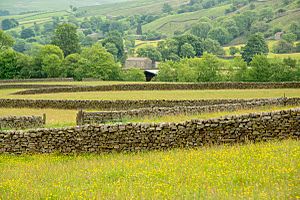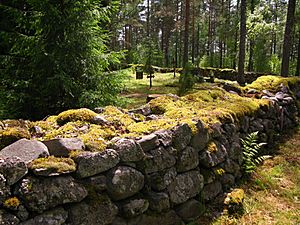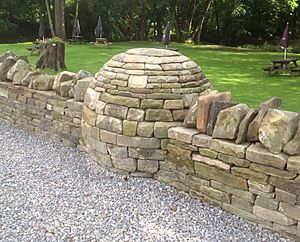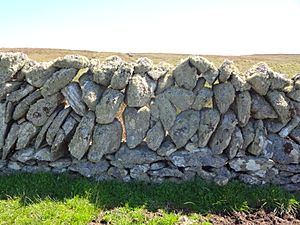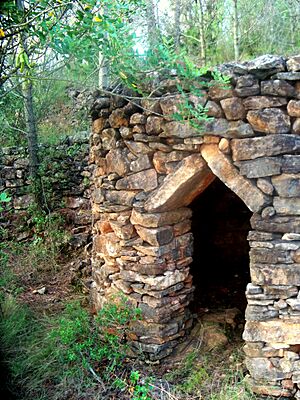Dry stone facts for kids
Dry stone is a special way of building things using only stones. No mortar (which is like glue for stones) is used to hold them together. These structures stay strong because the stones are carefully chosen and fit together like puzzle pieces. This creates a strong, load-bearing wall.
Dry stone building is most famous for stone walls. People traditionally used these walls to mark the edges of fields or churchyards. They also built them as retaining walls to hold back soil on hillsides. But dry stone can also be used for sculptures, buildings, and even bridges! However, this term usually doesn't include ancient styles that used very precisely shaped stones without mortar, like Greek temples or Inca architecture.
In 2018, the art of building dry stone walls was added to the UNESCO list of important human cultural heritage. This includes dry stone walls in countries like France, Greece, Italy, Slovenia, Croatia, Switzerland, and Spain.
Contents
History of Dry Stone Building
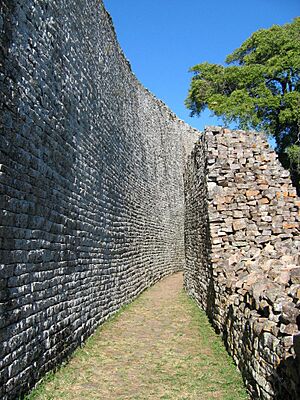
Dry stone walls have been built for a very long time. Some in northern Europe date back to the Stone Age. For example, in County Mayo, Ireland, a whole system of dry stone walls was found under peat. Scientists used carbon dating to find out they were built around 3800 BC.
In Belize, the ancient Mayan city of Lubaantun shows dry stone building from the 700s and 800s AD.
A huge city complex called Great Zimbabwe in Zimbabwe, Africa, was built using dry stone from the 1000s to the 1400s AD. It's the biggest of its kind in that area.
The strong, large walls of the acropolis in Mycenae, Greece, were built around 1350 BC. The walls of Tiryns were built even earlier.
Where Dry Stone Walls Are Found
The names for dry stone structures can change depending on the region. In Scotland, they are often called 'dykes'. People who build them professionally are called 'dykers'.
Dry stone walls are common in hilly parts of Britain and Ireland. This is where rocks are naturally found or where there are many large stones in the soil. They are especially common in western Ireland, like Connemara. You can also find them around the Mediterranean Sea, often as retaining walls on terraced land. These walls are built where there are lots of large stones, or where it's too windy or harsh for hedges to grow and keep animals in. Many thousands of kilometers of these walls exist, and most are hundreds of years old.
Dry Stone Walls in Other Countries
In the United States, dry stone walls are common in places with rocky soil. This includes New England, New York, New Jersey, and Pennsylvania. They are also a key feature of the bluegrass region of central Kentucky and Virginia. Here, they are usually called rock fences or stone fences. The Napa Valley in northern California also has them. English and Scots-Irish immigrants mainly brought this building method to America.
The technique also traveled to Australia (especially western Victoria, parts of Tasmania, and around Kiama) and New Zealand (especially Otago).
Similar walls are found near the Swiss–Italian border. They often enclose spaces under large natural rocks. In Bohemia, a region in the Czech Republic, dry stone walls line fields. They are built from stones removed from the land. These walls act as fences for cattle and sheep.
Dry Stone Walls in Croatia
In November 2018, Croatia's dry stone wall tradition was added to the UNESCO list of Intangible Cultural Heritage. This was alongside traditions from Cyprus, France, Greece, Italy, Slovenia, Spain, and Switzerland. In Croatia, dry stone walls (called suhozidi) were built for several reasons. People built them to clear stones for farming, to mark land ownership, or to get shelter from the strong bora wind. Some walls are very old, dating back to the Liburnians. A famous example is Baljenac island, which has 23 kilometers (about 14 miles) of dry stone walls, even though it's only 14 hectares (about 35 acres) big.
Inca Dry Stone Architecture
In Peru, during the 1400s AD, the Inca people used dry stone walls to create terraces on steep hillsides. This made the land usable for farming. They also built freestanding walls. Their famous ashlar style, seen in Machu Picchu, uses polished stones that fit perfectly without mortar. The Incas were masters of this skill. Many stone joints are so tight that you can't even fit a knife blade between them. These structures have lasted in an earthquake-prone area because the walls are flexible. Also, in their double-wall buildings, the two parts of the walls lean into each other for extra strength.
How Dry Stone Walls Are Built

The way a dry stone wall is built changes based on the type of stone available. It also depends on what the wall will be used for and local traditions. Many old walls were made from stones cleared from fields for farming. Modern walls almost always use quarried stone.
Double Walls
One common type is a "double" wall. It has two rows of stones placed along the boundary. The first stones are set into the ground for a firm base. The rows are built with large, flat stones at the bottom, getting smaller as the wall gets taller. Smaller stones can be used to fill gaps if the main stones are round.
The wall is built layer by layer. At certain points, large "tie-stones" or "through stones" are placed. These stones go all the way across both faces of the wall. They connect the two thin walls, making the whole structure much stronger. Making the wall narrower as it gets higher also adds strength. The spaces between the outer stones are carefully filled with smaller stones, called "hearting."
The very top layer of the wall has large stones called "capstones" or "coping stones." Like tie stones, capstones span the full width of the wall. They help prevent the wall from falling apart.
Special Openings
Besides gates, walls can have small openings for animals. Tiny holes, about 8 inches (20 cm) high, are called "Bolt Holes" or "Smoots." Larger ones, 18 to 24 inches (45 to 60 cm) high, are called "Cripple Holes."
Single Walls and Other Styles
Boulder walls are a type of single wall. They use large boulders as the main structure, with smaller stones placed around them. Single walls work best with large, flat stones. The biggest stones should be at the bottom, and the wall should get narrower towards the top.
Galloway dykes have a base of double-wall construction or large boulders, with a single wall on top. They look a bit wobbly and have many holes. This design actually stops animals (and people) from trying to cross them. These dykes are found in very windy places. The holes let the wind pass through, which helps the wall stay stable.
Another style is the Cornish hedge or Welsh clawdd. This is an earth bank covered with stones, topped with grass or trees. It has a distinct inward slope. Like many walls, its height is usually the same as its base width, and its top is half the base width.
Different regions have slightly changed the building methods. This is sometimes due to the available stones or to create a unique local look. No matter the method, building a dry stone wall requires great skill. Fixing mistakes often means taking down the wall to where the error was made. Choosing the right stone for each spot makes a huge difference in how long the wall lasts. A skilled wall builder takes time to select each stone carefully.
Today, there are fewer skilled wall builders. Modern wire fences are quicker and cheaper to install. However, dry stone walls are very sturdy and last a long time with little maintenance. Because people now appreciate the beauty and history of dry stone walls, skilled builders are still in demand. In the UK, there's even a certification program for dry stone wallers.
Some famous dry stone walls include:
- The Mourne Wall: a 22-mile (35 km) long wall in the Mourne Mountains in County Down, Northern Ireland.
- Ottenby nature reserve: built by Charles X Gustav in the mid-1600s in Öland, Sweden.
Other Uses for Dry Stone
While dry stone is mostly used for walls and terraces, it can also be used for sculptures, buildings, forts, and bridges.
Traditional Scottish Highland blackhouses, which had turf roofs, were built using the double-wall dry stone method. The middle of these walls was often filled with earth or sand to stop drafts. In the Iron Age, this technique was also used for forts like Eketorp Castle in Sweden and Dunlough Castle in Ireland. Many dry stone walls in Scotland today date back to the 1300s or earlier. They were built to divide fields and keep livestock.
Dry stone walls can also be built against hillsides or steep terraces. If they hold back soil, they are called retaining walls. The weight of the stones holds back the pressure from the soil. Dry stone retaining walls were once built a lot for farm terraces and to support paths, roads, and railways. Many are still used and maintained today. New ones are often built in gardens and nature areas.
In northeastern Somalia, there are ruins of an ancient monument built in a platform style. It has a low, rectangular dry stone wall filled with rubble. Large standing stones are at its corners. Nearby are graves outlined with stones. This structure is 24 meters (79 feet) by 17 meters (56 feet).
In Great Britain, Ireland, France, and Switzerland, you can find small dry stone structures used as signs. They mark mountain paths or land boundaries. In many countries, these piles of stones, called cairns in Scotland, are used as markers on roads and mountain tops.
Images for kids
-
"Cabane de Malais" at Souvignargues, Gard, France
-
Dry stone wall with window in Bignasco, Switzerland (Swiss-Italian part)
-
Adding a dry stone wall to convert the space under a large rock into a functional building near Bignasco, Switzerland
-
A stone terrace created using dry stack techniques in North Carolina
-
Intihuatana ritual buildings of dry stone at Machu Picchu, Peru
See also
 In Spanish: Piedra seca para niños
In Spanish: Piedra seca para niños
- Anathyrosis (Greece)
- Broch (Scotland)
- Building material
- Cabanes du Breuil (France)
- Dry stone hut
- Great Zimbabwe (Zimbabwe)
- Machu Picchu (Peru)
- Mending Wall (US)
- Nuraghe (Sardegna)
- Stone industry
- Stora Alvaret (Sweden)
- Trullo (Italy)
- Village des Bories (France)


